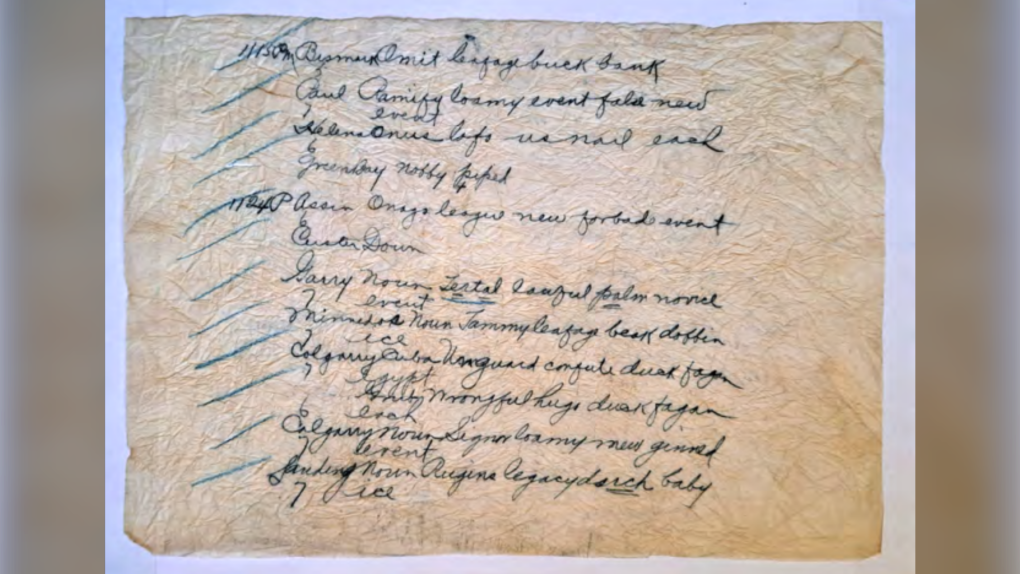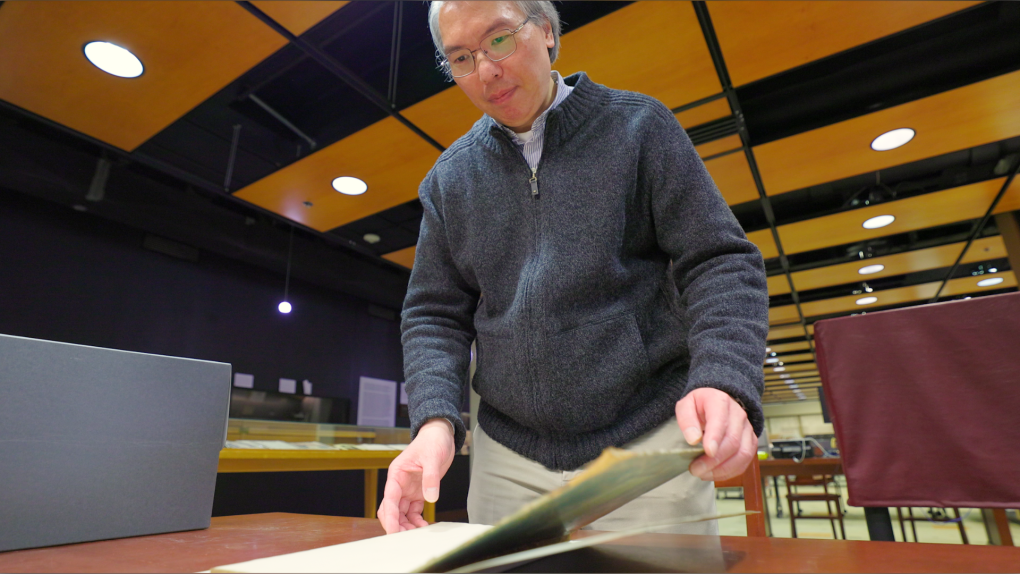Cracking the code: Messages found in silk dress decoded by Manitoba researcher
Coded messages found in the folds of a Victorian-era dress were finally cracked by a University of Manitoba researcher almost a decade after they were discovered.
The code, dubbed The Silk Dress Cryptogram, was once considered one of the top 50 unsolved codes in the world until it was cracked by Wayne Chan in 2022.
“It was a good feeling that after, you know, close to 10 years, it was finally solved,” Chan said about his efforts which were published in the August 2023 edition of the journal, Cryptologia.
WHAT WAS THE SILK DRESS CRYPTOGRAM?
The dress was purchased for $100 in Maine in 2013 by Sara Rivers Cofield, an archeological curator. When she examined the dress closely, she discovered a hidden pocket containing two handwritten notes made of apparently random words. One sentence, for example, has the line, “Smith, nostrum, linnet, get, none, event.”
 The hidden pocket on the dress where the letters were found (Photo courtesy: Sara Rivers Cofield)
The hidden pocket on the dress where the letters were found (Photo courtesy: Sara Rivers Cofield)
Rivers Cofield posted images of the message on her blog asking cryptologists and codebreakers to help solve the puzzle but no one was able to solve it. It was then picked up by crypto-historian Klaus Schmeh’s blog as one of the top 50 unsolved codes and ciphers, ranking 32nd, 30 spots below the Zodiac Killer letters.
 The first coded message found inside the dress (Courtesy: Sara Rivers Cofield)
The first coded message found inside the dress (Courtesy: Sara Rivers Cofield)
 The second coded message found inside the dress (Courtesy: Sara Rivers Cofield)
The second coded message found inside the dress (Courtesy: Sara Rivers Cofield)
'JUST TRYING TO FIGURE OUT A MYSTERY'
Chan, a research computer analyst with the Center for Earth Observation Science at the U of M, has had a passion for cryptology and secret message since he was a kid.
“I remember having like a kids’ book about code breaking when I was in elementary school, and that's probably how it came about,” he said. “Of course, back then I couldn't convince any of my friends to get interested in the same thing as I was.”
He got back into the hobby as an adult and in 2018 came across the Silk Dress Cryptogram, recognizing it was a telegraphic code based on the era of the dress and use of unencrypted, understandable words that don't make sense.
“I’m just trying to figure out a mystery, something that’s hidden,” he said, “For a few months, I didn't get anywhere, because I thought it was a telegraphic code called Slater's Code, which is a very common telegraphic code back in the 1880s.”
He said he gave up for a while and didn’t look again until the holidays last year when he had some free time.
“I was almost at the point of giving up again for another year,” he said. “Then I decided to take a step back from what I was doing, which was examining a whole bunch of different code books. I looked through about 170 of them, but wasn’t getting anything that matched the code sheets.”
 Wayne Chan, a researcher at the University of Manitoba, cracked the Silk Dress Cryptogram in 2022. (Photo courtesy: University of Manitoba)
Wayne Chan, a researcher at the University of Manitoba, cracked the Silk Dress Cryptogram in 2022. (Photo courtesy: University of Manitoba)
Chan’s plan was to read old literature about the telegraph, and came across a book from 1880 about different uses of the telegraph in different industries.
“I came across a section of the book which was talking about weather codes, and I realized the examples they were giving in that section look fairly close to the lines of code from the dress,” he said.
The lines were determined to be weather codes used by the U.S. Army Signal Service to share weather from different stations. The first word in the line was the station location, while each word that followed referred to items such as pressure, temperature, dew point, wind direction and clouds.
The line “Smith, nostrum, linnet, get, none, event,” referred to a reading from the station at Fort Smith, Arkansas. The air temperature at the time was 70 degrees Fahrenheit, and the dew point was 64 degrees Fahrenheit, with cloudy skies and wind from the southeast.
Chan was also able to find that the observations were made on May 27, 1888, according to his paper. He believes the dress was owned by a woman working as a clerk at the Washington, D.C., office of the signal service.
“My argument is that anybody in possession of all these weather reports had to be at the Washington office, which received all the telegrams from across the United States,” he said.
Chan said the process of cryptology is fun, but warns people who are getting into it to not get too absorbed in the hobby and be careful before claiming they’ve solved something.
“If you think you have a solution to one of the major unsolved ciphers, it's best to get somebody who's knowledgeable in cryptology to look at it before going public with it,” he said, adding his findings were published this year after being peer-reviewed.
CTVNews.ca Top Stories

Teenage phenom Gavin McKenna scores, Canada tops Finland 4-0 in world junior opener
Teenage sensation Gavin McKenna scored late in the first period and Carter George made 31 saves for the shutout as Canada picked up a 4-0 victory over Finland in the host country's opener at the world junior hockey championship Thursday.
Ministers Joly, LeBlanc travel to Florida to meet with Trump's team
Two members of Prime Minister Justin Trudeau's cabinet will be in Palm Beach, Fla., Friday to meet with members of Donald Trump's team.
Hwy. 401 off-ramp shut down due to Boxing Day deal-hunters now reopen
A Highway 401 off-ramp west of Toronto that became so clogged up with Boxing Day deal-hunters Thursday that police had to shut it down out of safety concerns has re-opened.
India alleges widespread trafficking of international students through Canada to U.S.
Indian law enforcement agencies say they are investigating alleged links between dozens of colleges in Canada and two 'entities' in Mumbai accused of illegally ferrying students across the Canada-United States border.
Teen actor Hudson Meek, who appeared in 'Baby Driver,' dies after falling from moving vehicle
Hudson Meek, the 16-year-old actor who appeared in 'Baby Driver,' died last week after falling from a moving vehicle in Vestavia Hills, Alabama, according to CNN affiliate WVTM.
B.C woman awarded nearly $750K in court case against contractor
A B.C. woman has been awarded nearly $750,000 in damages in a dispute with a contractor who strung her along for a year and a half and failed to complete a renovation, according to a recent court decision.
Florida pizza deliverer charged with stabbing pregnant woman after tip dispute
A pizza deliverer in central Florida has been charged with pushing her way into a motel room with an accomplice and stabbing a pregnant woman after a dispute over a tip, authorities said.
2 minors, 2 adults critically injured in south Calgary crash; incident was preceded by a robbery
Multiple people were rushed to hospital, including two minors, in the aftermath of a serious vehicle collision on Thursday morning.
Christmas Eve stowaway caught on Delta airplane at Seattle airport
A stowaway was caught trying to nab a ride on a Delta Air Lines plane at Seattle-Tacoma International Airport on Christmas Eve.
































